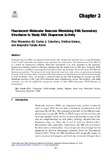Mostrar el registro sencillo del ítem
Fluorescent molecular beacons mimicking RNA secondary structures to study RNA chaperone activity
| dc.creator | Menéndez Gil, Pilar | es_ES |
| dc.creator | Caballero Sánchez, Carlos | es_ES |
| dc.creator | Solano Goñi, Cristina | es_ES |
| dc.creator | Toledo Arana, Alejandro | es_ES |
| dc.date.accessioned | 2020-05-21T09:23:39Z | |
| dc.date.available | 2020-05-21T09:23:39Z | |
| dc.date.issued | 2020 | |
| dc.identifier.isbn | 978-1-0716-0230-0 | |
| dc.identifier.uri | https://hdl.handle.net/2454/36950 | |
| dc.description.abstract | Molecular beacons (MBs) are oligonucleotide probes with a hairpin-like structure that are typically labelled at the 5′ and 3′ ends with a fluorophore and a quencher dye, respectively. The conformation of the MB acts as a switch for fluorescence emission. When the fluorophore is in close proximity to the quencher, fluorescence emission cannot be detected, meaning that the switch is in an OFF state. However, if the MB structure is modified, separating the fluorophore from the quencher, the switch turns ON allowing fluorescence emission. This property has been extensively used for a wide variety of applications including real-time PCR reactions, study of protein-DNA interactions, and identification of conformational changes in RNA structures. Here, we describe a protocol based on the MB technology to measure the RNA unfolding capacities of the CspA RNA chaperone from Staphylococcus aureus. This method, with slight variations, may also be applied for testing the activity of other RNA chaperones, RNA helicases, or ribonucleases. | en |
| dc.description.sponsorship | This work was supported by the European Research Council (ERC) under the European Union's Horizon 2020 research and innovation program (Grant Agreement No. 646869) and the Spanish Ministry of Economy and Competitiveness (BFU2014-56698-P). C.J.C. was supported by a predoctoral contract from the Public University of Navarre (UPNA), Spain. | en |
| dc.format.extent | 18 p. | |
| dc.format.mimetype | application/pdf | en |
| dc.language.iso | eng | en |
| dc.publisher | Humana Press | en |
| dc.relation.ispartof | Heise T. (eds) RNA Chaperones. Methods in Molecular Biology. New York: Humana Press, 2020, pp. 41-58. ISBN 978-1-0716-0230-0 | en |
| dc.rights | © The Author(s) 2020. This chapter is licensed under the terms of the Creative Commons Attribution 4.0 International License, which permits use, sharing, adaptation, distribution and reproduction in any medium or format, as long as you give appropriate credit to the original author(s) and the source, provide a link to the Creative Commons license and indicate if changes were made. The images or other third party material in this chapter are included in the chapter's Creative Commons license, unless indicated otherwise in a credit line to the material. If material is not included in the chapter's Creative Commons license and your intended use is not permitted by statutory regulation or exceeds the permitted use, you will need to obtain permission directly from the copyright holder. | en |
| dc.rights.uri | http://creativecommons.org/licenses/by/4.0/ | |
| dc.subject | RNA | en |
| dc.subject | Chaperone | en |
| dc.subject | RNA-binding protein | en |
| dc.subject | Hairpin | en |
| dc.subject | Stem loop | en |
| dc.subject | Molecular beacon | en |
| dc.subject | Fluorescein | en |
| dc.subject | Quencher | en |
| dc.subject | FAM | en |
| dc.title | Fluorescent molecular beacons mimicking RNA secondary structures to study RNA chaperone activity | en |
| dc.type | info:eu-repo/semantics/bookPart | en |
| dc.type | Capítulo de libro / Liburuen kapitulua | es |
| dc.contributor.department | Ciencias de la Salud | es_ES |
| dc.contributor.department | Osasun Zientziak | eu |
| dc.rights.accessRights | info:eu-repo/semantics/openAccess | en |
| dc.rights.accessRights | Acceso abierto / Sarbide irekia | es |
| dc.identifier.doi | 10.1007/978-1-0716-0231-7_3 | |
| dc.relation.projectID | info:eu-repo/grantAgreement/MINECO//BFU2014-56698-P/ES/ | en |
| dc.relation.projectID | info:eu-repo/grantAgreement/European Commission/Horizon 2020 Framework Programme/646869 | en |
| dc.relation.publisherversion | https://doi.org/10.1007/978-1-0716-0231-7_3 | |
| dc.type.version | info:eu-repo/semantics/publishedVersion | en |
| dc.type.version | Versión publicada / Argitaratu den bertsioa | es |
| dc.contributor.funder | Universidad Pública de Navarra / Nafarroako Unibertsitate Publikoa | es |
Ficheros en el ítem
Este ítem aparece en la(s) siguiente(s) colección(ones)
La licencia del ítem se describe como © The Author(s) 2020. This chapter is licensed under the terms of the Creative Commons Attribution 4.0 International License, which permits use, sharing, adaptation, distribution and reproduction in any medium or format, as long as you give appropriate credit to the original author(s) and the source, provide a link to the Creative Commons license and indicate if changes were made. The images or other third party material in this chapter are included in the chapter's Creative Commons license, unless indicated otherwise in a credit line to the material. If material is not included in the chapter's Creative Commons license and your intended use is not permitted by statutory regulation or exceeds the permitted use, you will need to obtain permission directly from the copyright holder.



